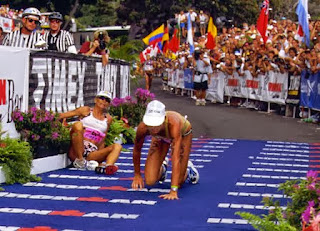Running blog series: Part 3: Running technique:
Obviously running techniques will differ from person to
person, likewise a marathon runner with have a different technique than a 100m
sprinter but we will discuss things more generally then it is up to you to add
your personal tweaks to it to suit what you do.
Of late the issue with running technique is that everyone is
fixated on barefoot running or forefoot running. Well this article will try to
cover this issue but trust me it’s not all about the feet!
Due to this current trend lots of runners are trying to turn
themselves into forefoot runners but many runners aren't ready for it and
actually may not even need or benefit from it.
If you know that you will benefit from this change then you
need to learn to become more efficient (lighter) within your heel strike
firstly and then to shorten your stride length gradually. At each stage the
change needs to become second nature before changing. Finally you can start to
change the way the foot lands to mid foot and if required forefoot impact.
However as you can see below, certain injuries are common with the forefoot and rearfoot strikers:
- Metatarsal stress fractures
- Dorsal midfoot interosseous compression syndrome
- Posterior tibial tendonitis
- Achilles tendonitis
- Calf strains
More common in heel striking running:
- Knee pain
- Tibial stress fractures
- Anterior compartment syndrome
The evidence suggests:
Running with a rearfoot strike has significantly higher
rates of repetitive stress injury than a forefoot strike (Daoud et al 2012).
Evidence shows that rearfoot striking runners are more
economical than midfoot strikers (Ogueta-Alday et al 2013).
So before trying to change your style, ask yourself why are
you changing? If the answer is because of injury, for example you are getting a
knee pain and you think it’s because of being a heel striker, then first just
try to land softer with the same heel strike and see what happens. If this
isn’t enough then slowly shorten your stride length and continue to progress
the above changes if you need to. However if your knee pain goes then you have
done enough tinkering and any further changes will potentially create new
problems.
Right now that’s out of the way.
It’s not all about your feet!!!!
Posture:
You need to keep upright with a slight lean forward from
your ankle not your waist. Having good gluteal and core strength and endurance
will help this. You also need a high knee lift, which requires good hip flexor
(iliopoas) strength and flexibility. Basically just try to keep good general
alignment/ posture but stay relaxed. How many times do you feel your neck and
shoulders tightening up? So try to be careful not to let your shoulders ride
up. Try to keep your shoulder blades together and slightly down.
Cadence:
Another element to work on is cadence. Try to speed this up
and spend less time in contact with the ground. Make sure that you contact the
ground with your foot underneath your bent knee that is nearly underneath your
hip. Over striding causes braking forces, which will slow you down, make you
less efficient and apply extra forces through your body and therefore increase your
risk of injury.
Research also shows that Increasing running step rate is an
effective strategy to reduce patellofemoral joint forces (Lenhart et al 2013).
Level running:
You need to keep an adequate bend in your knees so that your
body isn’t bobbing up and down. You should be staying pretty level while
running. Remember you want to move forwards not up and down. Not only will this
waste energy and slow you down but it will increase the impact of running and
increase the risk of injury.
Upper body:
Remember that running involves your whole body so try to
co-ordinate you trunk rotation and arm swing in the opposite motion of your
legs as this will increase your stride length without over striding and it will
create support through fascial slings in your body. A great example of this is
the sacroiliac joint, which is supported on impact due to the stretch through
the fascia attaching from the latisimus dorsi on one side to the gluteals on
the opposite side.
The arm swing also controls rotation and changes rotational
direction to power the legs. Try running with your arms across your chest, it’s
not easy and you will find it hard work to control your rotation.
Fatigue:
Kinematics when fatigued, deteriorated, which is associated
with an increase in injury risk & poor running form (Koblbauer et al 2012).
So when tiring and technique starts to deteriorate don't just carry on as injury risk will skyrocket. If you really want to push yourself then do this in your cross training sessions, for example hammer the swimming or cycling.
Okay so how do I know whether I am doing these things or not?
If you are unsure then consider filming your running yourself from the front and the side as this can highlight issues with your technique. This will in turn tell you what you need to focus on, stretch out or strengthen anything.
Commonly I have seen too much side to side movement of the
pelvis, dropping of the non-weight bearing side of the pelvis and the knee
moving inwards in stance. What I would then advise, is to work on the issues
found, which could be weak gluteals, tight ITB, poor core stability or poor
pronation control.
Everyone is different so see what issues are there and work
on them then after several weeks or even months depending on the issues found;
you should re-film and compare them to see if your technique is better.












Comments
Post a Comment